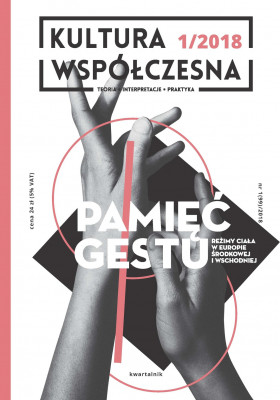Settings and search
Memory of a gesture. Body regimes in Central and Eastern Europe


Table of contents
I MEMORY OF A GESTURE. BODY REGIMES IN CENTRAL AND EASTERN EUROPE
Anastasia Nabokina
Introduction. Memory of a gesture
Oksana Bułgakowa
Russian body cinema of the 50s’ – between “us” and “them”
Irina Sirotkina
The avant-garde’s sixth sense: art as a bodily knowledge
Anastasia Nabokina
Body lab: Kasyan Goleizovsky and the new dance in Russia in the early 20th century
Małgorzata Radkiewicz
“Working hands” in photo documentation of Janina Mierzecka and medical records of Henryk Mierzecki
Wojciech Klimczyk
Reytan as the nation’s totem. Amnesia of a gesture
Ewa A. Majewska
Ewa Partum’s lipstick trace. From kiss to political abundance
Tomasz Ciesielski
Consciousness montage – neurocognitive analysis of Meyerhold’s practices
II GESTURE IN CULTURE
Michał Murzyn
Is heritage liquid?
Filip Wróblewski
Ethnographer in the field. Gesture (in) photography
Iwona Grodź
Words, gestures and knowledge in film interaction. The case of the Decalogue I by Krzysztof Kieślowski (1988)
Justyna Kijanka
Gestures of the absent bodies. Sedmikrásky (daisies) by Věra Chytilová as an example of experimenting with corporealness in the Czechoslovakian New Wave cinema
Grzegorz Piotrowski
Single entities. Emigration of polish jazz and pop musicians
III REVIEWS
Paulina Sosnowska
Between the continuity and the break-up. What’s left of Bildung
Magdalena Woźniewska-Działak
Political fiction Marka Migalskiego
MEMORY
Juliusz Tyszka
Zbigniew Osiński (1939–2018)
Memory of a gesture. Body regimes in Central and Eastern Europe
The article analyses the changes of a Soviet man’s bodily language shown in the films of the late 1950s’ and early 1960s’. The author observes how foreign movies shown on Russian screens with great delay had been changing the bodily language of Russian film characters and the impact of a significant gender roles switch so vivid in post-war Western European and American cinematic productions. Getting rid of a tight pattern of gesture in the world of cinema has become a phenomenon almost as important as the political thaw. This approach is particularly visible in the images of the workers’ bodies, working class people brought up in children’s homes and living in dormitories – the youth portrayed in films such as Under the Clouds, Girls, I am 20, Dima Gorin’s Career, Spring on Zarechnaya Street, Walking around Moscow. By observing the process of an on-screen change of bodily techniques one may assume that the body doesn’t have a memory of its own, and therefore imitates new techniques easily; the body keeps the memory of a gesture and acquires new habits with much difficulty. Soviet films subsequently suggest both approaches.
The author attempts to define the role of the artist’s body in his/her creative actions, as well as the significance of the artist’s moves and the feeling of one’s own movements – the “sixth” or “muscular” sense, kinesthesia. For this purpose, the author examines the Russian avant-garde art. The project, both anthropological and artistic, involved the concept of the re-creation of a human being and the renewal of human senses. The new kind of “free”, “smooth” dance, introduced in Russia by Isadora Duncan, played an important role in the development of the avant-garde movement. Dance, body movement and physical culture contributed substantially to the project of “Life Bildung” – an attempt to improve everyday life by investing art in it. In shaping the new genre of performance art, the avant-garde artists also relied on their bodily movements and sensations.
The article is devoted to the role of dance seen as a laboratory of bodily culture. The idea is analysed using the example of a lesser-known area of the Russian culture from the first three decades of the 20th century – the so-called “free dance” – and the creation of Kasyan Goleizovsky. The sources of the new dance are being placed in the tradition of a Russian symbolism, as well as in an early 20th century anthropological project focusing on the change of human nature inspired by the ideas of F. Nietzsche and W. Ivanov. Drawing inspiration from the vision of theatre as a Dionysian practice, making collective spiritual revival possible, dancing becomes both a body releasing and a body restrictive practice.
The text analyses the unique publication called A working hand (1939) by a Lvov-based dermatologist Henryk Mierzecki, which also includes his wife’s photos. The analysis of their collaborative medical-artistic project reveals how a developing occupational medicine tried to describe the relationship between the bodies of certain people and their everyday work or occupation. The research was based on diagnoses of health damage and different stages of disease caused by working environment, working tools and external factors. Mierzecki’s thoughts can be interpreted in the context of photographical and archiving research – as Allan Sekula did. Photography was an important part of the project for dr Mierzecki – he used it as an illustration, a catalogue tool and a user’s manual helping to identify certain cases. His wife’s photographs are regarded as an example of artistic expression used as means of scientific documentation, where an aesthetic aspect is as important as a cognitive one. The whole project is also categorised as representing working people. This representation, as well as its loss, has been analysed by Georges Didi-Huberman and regarded by him as possible to obtain by mechanical reproduction and the cinematic and photographic media.
The article encourages treating an image of a gesture as a complex cultural event – a communication process, where following interpretations of an image reconfigure the initial gesture. This requires treating a presented gesture in terms of an argument, that is – as a political issue. As we embrace this approach by analysing Reytan’s gesture known from the Matejko’s famous painting, the article calls for a methodology of observing gesture while emphasising not its memory, but rather its amnesia, meaning the alternatives forgotten (psychologically repressed) in the process of gesture’s development.
We usually associate memory with facts. A simple gesture of leaving a lipstick trace, a kiss, used for several decades by Ewa Partum, is a form of leaving your mark, as well as representing your emotional state. It has become the artist’s trademark. At first, it was her individual gesture, a kind of artistic signature. In 2006 Partum invited a group of South African immigrants to perform the signature with her. I’d like to find out what is actually included in this artistic act, how it surpasses the border between the private and the public and how it becomes a specific form of materialised universalism, the practice of a shared thing.
The article suggests using the context of the latest neurocognitive research as a source of a new paradigm used in knowledge of theatre area analysis. It can be used in reinterpreting historical aesthetics of the performing arts and its cognitive-imaginative patterns. The analysis of Vsevolod Meyerhold’s practice, carried out with the use of contemporary works focusing on the topic of perception of emotions and movement and neuronal simulation rooted in the concept of the embodied cognition.
Gesture in culture
In the 1970s the UNESCO Convention Concerning the Protection of the World Cultural and Natural Heritage introduced a new term regarding historic preservation – heritage. It has replaced the previously used term “cultural object”. It was a time when postmodern tendencies started being popular. The goal of this article is to find an answer to the question: is heritage postmodern? For this purpose the mechanisms observed and explained by Zygmunt Bauman in Liquid modernity were compared and referred to the rudiments of heritage.
Three collections of photographs depicting ethnographical research are subject of analysis. The author uses them to show differences between local and foreign patterns of working in the field. The significant role of wandering is stressed as a unique property of ethnographers’ work. Another factor strongly influencing this professional group’s habitus is class distinction, typical for bourgeois circles. It is said to affect the way the subjects of research are usually treated. Also, the author muses over the relationship of photography as a medium and a peculiar act of collecting and gathering, so typical for ethnography.
The paper concentrates on the verbal and nonverbal (mimics, gestures) aspects of human-human and human-computer communication, both of which are present in Krzysztof Kieślowski’s Decalogue I. In the first part of my text, I will make an extensive study of the scenes in the film, in which the director reflects on the crux of interpersonal communication (human-human): a conversation between the father and the son; a conversation between the boy and his aunt; the main character’s lecture on communication. In the second part, I will describe Kieślowski’s film which is a pioneering work as it creates statements about the new ways of interpersonal communication, connected with technicalization: a human-computer communication. Detailed analysis of the scenes: “the conversations” between the boy and his mother via the computer; spontaneous starting/start-up of the computer; mathematical “genius” of the machine. In the conclusions, I will mention the director’s reflections on the communication in the year of 1988, which are still up-to-date, as well as those that have outdated.
This article deals with the issue of ‘absent corporealness’, as shown in the movie Sedmikrásky (Daisies) by Věra Chytilová. The director deconstructs the concept of femme (and fille) fatale, showing femininity that releases itself from the control of male phantasms by breaking the taboos and balancing on edge of what is acceptable or not. Corporealness and the world shown in the movie are being deconstructed, but also presented as a destructive factor. Heroines transgress from a world that they perceive to be ‘corrupt’ and meaningless, a world, where a gesture has lost its original meaning.
Jazz and pop music representatives are a particularly mobile group of musicians. This is mainly due to the fact of pop music market being dependent on financial factors, channels of distributions and technology. The hybridization of popular music faces it with the migrating, creative human element, and the migration itself undergoes numerous changes in the reality of global, digital world. The author focuses on the tendency of Polish jazz and pop musicians to emigrate. The phenomenon is analysed in the changing cultural, social and political contexts. By interpreting the different fates of musicians representing various generations (B. Kaper, H. Wars, Z. Seifert, M. Urbaniak, T. Stańko), the author distinguishes different waves of emigration and individual motivations, as well as more universal reasons for emigration.
